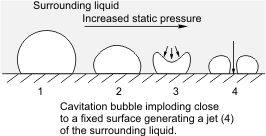Cavitation
Cavitation is cavity(from the Latin word cavitas) in liquid, which arises as a result of violent changes of pressure or it could be the phenomenon of the formation of these cavities.
Type of cavitation[edit | edit source]
Intertial cavitation[edit | edit source]
Intertial cavitation arise single acting forces. If traction forces in liquid overcome cohesive and hydrostatic forces, it will broke the continuity of liquid and small cavities are formed. It happens in place, where are small inhomogenity, which is called as cavitation seed. We can imagine it simply as vacuum bubbles. In fact cavity contains steam of sorrounding fluids,which penetrate by diffuses through the cavitation walls of cavity. Into the cavity penetrate also gases, which were originally dissolved. Cavity can contain gas in the beginning, because microbubbles of gas work as appropriate cavitation seed. There can be broken easily the continuity of fluid.
Collapse of this type of cavitation is extremly dramatic phenomenom. As long as the external tensile( negative pressure) forces prevails over the cohesive and hydrostatic forces, cavity is getting bigger. At the moment when the tensile forces stop to act and intertial motion is exhausted, the growth of cavity is stoped and cavitation starts to collapse. It is expedited by external forces and the walls of cavitation bubble is collapsing back to the center. Collapse is usually asymmetrical. Walls of cavitation bubble is broken at first in one place and liquid from there in the form of a narrow jet is directed to the opposite side of cavitation cavity. The speed which this jet of liquid hits the opposite side can be many times the speed of sound. At the point of impact of cavitation jet occurs to sharp local pressure increase(>10000 Bar) and temperature(>3000 °C). The liquid in place of impact is changed to red-hot plasma, which radiates in a wide range of wavelengths including X-ray for a short time. If the collapsing cavitations come into contact with sollid matter, it occures on the surface of solid material to form microscopic craters and with prolonged explosure to erosion of the material.
Noninertial cavitation[edit | edit source]
Noninertial cavitation are small bubbles of gas, on which the acoustic field acts(mailny Ultrasound) while the intensity of acustic field usually cannot cause collapse of whole bubble. Effect of periodic changes of pressure in acustic field leads to oscilation of bubble size. This type of cavitation does not have so much dramatical progress and it is used for surface cleaning in ultrasonic washers.
Manifestations of cavitation[edit | edit source]
Collapse of cavitation cavity goes so fast that we can describe as adiabatic process. In the bubble, which is compressed into miniatures dimensions, it occurs to a sharp increase of pressure and temperature. It could be accompanied by chemial and physical changes. The specific nature of ongoing changes is also influenced by chemiacal composition of gas in the bubble. The essence of chemical changes is mainly formation and recombination of free radicals. Bubble collapse can be escorted by creation of shock waves. If the cavitation bubble is on the interface of solid and liquid, sharp jets of liquid can erode the surface sharper. This effect is so strong that materials are not able to resist for a long time. A special manifestation of cavitation is formation of light flashes, sonoluminiscence, which physical essence is the subject of research.
Sources of cavitation[edit | edit source]
Cavitation can be started also other events than harmonic propagation of acustic waves. In addition to medicine, cavitation is used to rapidly flow around certain objects e.g. turbine blades or propeller. Cavitation can also be accompanied similarly by shock wave propagation of liquid.
Cavitation is treshold phenomenon. It means that it appears only, when it is achieved in the surroundings certain acoustic pressures/ intensity.
Use of cavitation[edit | edit source]
Cavitation is applicable in applications where it is needs to be achieved to tissue destruction whether by heating or some other type of destruction. In the case of tissue destruction by ultrasound, the interaction of heating and cavitation is applied. Exceeding the cavitation treshold leads to an increase in the dissipation of the mechanical energy of the acoustic wave. We most often use cavitation for a lithotripsy shock wave, where cavitation is on the interface flid-concretion and it is used for crushing mechanism, which is secondary.
Cavitation as a risk factor[edit | edit source]
When using diagnostic ultrasound, the risk of cavitation is low, so US is safe. For assessment of risks of cavitation formation at a specific setting is used quantity called mechanical index. It is defined by the relation:
MI=p/√f
,,p,, is estimated amplitude of acustic pressure in tissue. ,,f,, is frecvention of ultrasound.
The vast majority of modern devices displays current value of mechanical index on the screen.
References[edit | edit source]
- ČÍŽEK, Martin. Analýza nelineárních dějů v ultrazvukové diagnostice. Brno : Ústav biomedicínského inženýrství FEKT VUT, 2009,
- MORNSTEIN, Vojtěch. Ultrazvuková kavitace: Využití, problémy a rizika v biologii a lékařství. Brno : Biofyzikální ústav LF MU, 1994,

